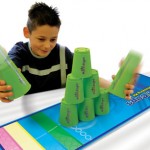Setup and Equipment:
- Four Playground Balls
- Four Medicine Balls
- Set of four balls of different shapes and sizes.
- Four cones and four polyspots
- Golf tubes and tennis balls
Guidelines: Teams line up behind the cone of their color team for directions
Round One: Over Under Relay
- The object is to be the first team to cross the finish line.
- Teams members line up in a line facing the finish line. Put a little space between them each other, so they can pass a ball behind each other down the line.
- The first person on each team raises the ball above their head.
- Leader says, “Go”
- The starting person on each team passes the ball between their legs, the person behind then raises the ball above their head and the over/under pattern continues until the last person gets it.
- When the ball gets to the last person in the line, that person runs all the way back up to the front, which will move the line forward. The pattern of over/under passing continues until all of the teams cross the finish line at the opposite end.
- Or you can see how many turns they can get in 3 minutes.
The Most Fun Wins!
Round Two: Boulder Passing (medicine ball)
- Teams stand in a line next to each other.
- Leave enough room for side to side passing:
The ball again starts in the front, but this time the ball will be pass from side to side. - When the ball gets to the last person in the line, that person runs all the way back up to the front, where the pattern of side to side passing continues until all of the teams cross the finish line.
Running Relay
- Break the four teams in half and line up one half in front of the starting spots and the other half behind the cones about 15 – 20 yards away.
- Each team has their color team playground ball.
Guidelines:
- The first person on each team has a ball. On the signal the first person on each team runs to the opposite end carrying the ball, then hands it to the next person in line, then goes to the end of the line.
- Continue until everyone is back to the starting position.
- Most fun wins!
Partner Ball Relays:
- Break the four teams in half and line up one half in front of the starting spots and the other half behind the cones about 15 – 20 yards away.
- The first two people on each team step stand behind their spots at one end, facing the rest of their team, standing behind the cone at the other end. If there is an odd number of people, teams may try to use three people to move the ball, or someone can volunteer to have a second turn
Round One: Shoulders
- Partners are given one ball, which they move the ball by balancing it between each other’s shoulder as they walk to the opposite end.
- Try to make a pass without dropping the ball. Go to the end of the line after each turn.
- Continue until everyone is back to the starting position.
- Round Two: Balance the ball between your shoulders.
- Round Three: Balance the ball between your hips
- Round Three: Balance the ball between backs, posteriors?!
Torch Relay: Carry and pass tennis balls with golf tubes.

